Mastering the Hand Washing of Silk Pillowcases
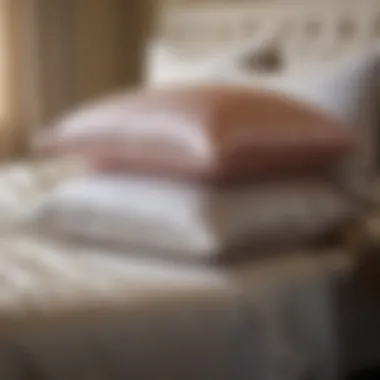
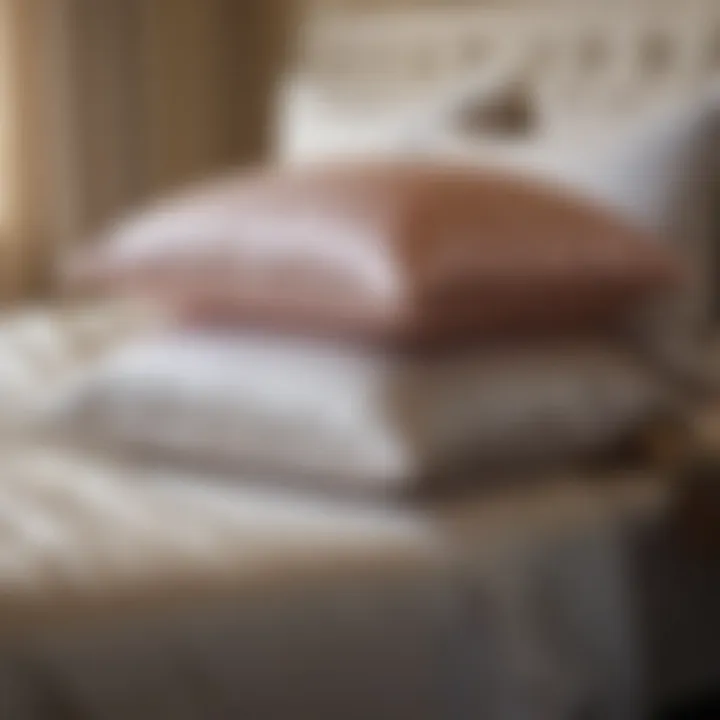
Intro
Silk pillowcases are not just a luxury; they're an experience of comfort. The way silk glides against your skin can elevate the quality of sleep to levels you've yet to imagine. However, caring for silk requires a delicate touch. If you handle them with an understanding of their unique properties, your silk pillowcases will retain their luster and texture for years to come.
Tea stains, makeup smudges, and various forms of grime often make their appearance, and some might consider tossing these beauties in the washer. But wait, it's crucial to grasp the art of hand washing. This approach ensures you protect the fabric's natural fibers from unraveling or fading. Rather than merely cleaning, you'll be preserving and respecting the craftsmanship that went into every thread of those luxurious pillowcases.
Understanding the significance of proper care is the first leap toward becoming a silk-savvy homeowner or a dedicated interior design enthusiast. In the following sections, we’ll guide you through the entire process of hand washing silk pillowcases, while also offering insights into maintaining and storing your cherished textiles.
Understanding Silk as a Material
Silk is more than just a fabric; it represents a blend of heritage and luxury that few materials can match. A deep dive into understanding silk is essential when caring for silk pillowcases. Knowledge of this material lays the groundwork for making informed choices that not only enhance the pillowcases’ longevity but also safeguards the investment in a premium sleep experience. Understanding the nuances of silk can elevate its care, ensuring that these pieces continue to offer comfort and aesthetic charm for years to come.
The Origin of Silk
The story of silk began in ancient China, where it is believed to have been discovered by accident. Legend has it that a silkworm cocoon fell into a cup of tea, and when the curiosity of the empress led to unraveling the fine threads, the beauty of silk was revealed. This precious material was so valued that it spurred trade routes such as the Silk Road, connecting East and West, and influencing cultures and economies alike. Knowledge of its origin speaks volumes about its significance in history, making it not simply a textile, but a symbol of prosperity and artistry.
Silk Characteristics
Softness
One of the first things that strikes anyone about silk is its incredible softness. This quality is a product of the fine fibers woven together in a way that creates a smooth surface. When you rest your head on a silk pillowcase, you immediately notice how gently it caresses your skin, providing a luxurious sensation that is hard to beat. This softness is not just for show. It helps reduce friction against the skin, which is especially beneficial for those who are concerned about wrinkles and skin irritation.
Lustre
Silk possesses a lustre that is simply unparalleled. The way light bounces off its surface creates an iridescent glow, adding elegance to any bedroom setting. This shimmering quality doesn’t only make silk eye-catching; it also reflects the care that goes into its creation. However, providing proper care ensures that this lustre is maintained over time, preventing dullness that can occur with improper washing or exposure to harsh chemicals. Thus, the preservation of silk's lustre is a key reason for understanding and practicing proper washing methods.
Breathability
When discussing breathability, silk emerges as a champion. Unlike many synthetic materials, silk allows air to circulate, which helps regulate temperature throughout the night. This characteristic means that not only do silk pillowcases offer a cool feeling on warm nights, but they also insulate during colder weather. This adaptability makes silk pillowcases a practical choice for year-round comfort, aligning perfectly with the desires of a discerning sleeper.
Why Choose Silk Pillowcases?
Silk pillowcases are not merely luxurious items; they offer real benefits that contribute to healthier skin and hair and improve sleep quality. Understanding these benefits can help individuals make the right choice when selecting bedding.
Skin Benefits
Silk is a natural hypoallergenic material, which means it repels dust mites and molds—common allergens that can wreak havoc on skin health. Those with sensitive skin or conditions like eczema often find relief when using silk. The smooth surface of silk pillowcases also minimizes skin irritation and fosters proper hydration, reducing moisture loss at night. Thus, indulging in silk isn’t just about comfort; it becomes a smart approach to skincare.
Hair Benefits
The benefits of silk extend to hair, making it one of the best materials for pillowcases. It reduces hair friction and breakage, meaning fewer split ends and a reduced likelihood of waking up with bed head. The fabric's smooth texture allows hair to glide effortlessly instead of tangling or snagging. For those on a quest for healthy hair, switching to silk pillowcases could be a game-changer.
Thermal Regulation
Lastly, thermal regulation offered by silk is an intelligent choice for anyone prioritizing comfort in sleep. Silk's inherent ability to regulate body temperature means that a user stays warm in winter yet cool in summer. This natural balance contributes to a better night's sleep, making silk pillowcases a wise investment for any home.
Remember, caring for silk properly only enhances its natural characteristics, keeping it soft, luminous, and breathable.
The Importance of Proper Care
When it comes to silk pillowcases, the attention you give to their care can make all the difference between a cherished luxery and a faded regret. Proper care not only extends the life of your pillowcases but enhances their exquisite qualities, making them a delightful addition to your bedding. Failing to follow appropriate washing and care techniques can lead to irreversible damage, diminishing their beauty and functionality.
Impact of Improper Washing
Improper washing is like throwing a wrench into the gears of what could be a long-lasting relationship with your pillowcases. Each aspect of mismanagement has its own set of consequences, including fading colors, texture damage, and shrinkage risks.
Fading Colors
One could say colors provide the personality of your silk pillowcases. Over time, improper washing can lead to their vibrancy fading into oblivion. The unique dyes used in silk are often sensitive to heat and harsh chemicals. When exposed to the wrong conditions, these colors don't just lighten; they become dull enough to tick you off every time you catch a glimpse. Once faded, there’s little chance of restoring those original hues. Choosing to wash silk gently preserves its aesthetic appeal, allowing the richness of the color to shine through.
Texture Damage

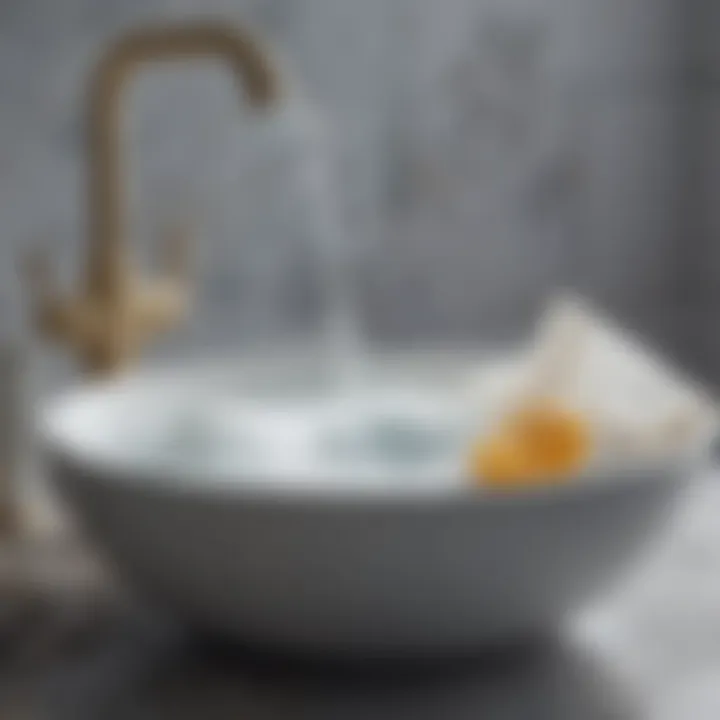
The texture of silk is proverbial for its softness, so when it takes a hit, it feels like a smooth whisper turning into an unwanted rasp. Damage to the texture occurs when pillowcases are tossed around in a machine or subjected to vigorous scrubbing. Instead of the luxurious feel you’ve come to love, you may end up with a coarser surface that simply lacks charm. Gentle handling during washing is essential to maintain that coveted texture, ensuring every night feels like a retreat into a luxury hotel.
Shrinkage Risks
Shrinking silk is about as welcome as a rainstorm at a sunny picnic. High temperatures and rough cycles can shrink your pillowcases beyond recognition, eventually transforming a once generous piece of fabric into something barely worth a glance. For those who enjoy their silk cozy yet spacious, understanding how shrinkage occurs is pivotal. By employing cautious methods, you not only prevent unwanted alterations but also keep your silk pillowcases fitting just right.
Hand Washing as an Optimal Method
Switching gears to hand washing—often dubbed the gold standard for silk care—it offers distinct advantages that machine washing simply can’t match. Whether it’s the personal touch or the level of control it affords, handwashing can significantly prolong the life of your silk accessories.
Benefits Over Machine Washing
The notable benefit of hand washing is that it allows for greater attention to detail. By carefully submerging your silk in cool water and treating it gently, you limit the likelihood of getting tangled or twist. Unlike machine washing, where pieces may clash and cause unwanted wear, hand washing provides a sense of security, letting you handle your silk as if it were a piece of art.
Preservation of Quality
Quality is what sets silk apart from other materials. Hand washing is not just a method—it's a promise to preserve the luxurious essence of the fabric. The aim is to retain its elegant drape and feel, ensuring that the pillowcases remain a treat for the senses. Concentrating efforts on this method strengthens the fabric’s fibers, leading to a longer lifespan.
"Proper care of silk isn't just about maintenance; it's about cherishing a fabric that embodies elegance and refinement."
In summary, understanding the importance of proper care for your silk pillowcases cannot be overstated. By avoiding improper washing and embracing hand washing techniques, you're setting the groundwork for both longevity and exquisite appeal. Remember, each gentle wash and careful dry serves to compliment the elegance woven into those fibers.
Preparation for Washing
When it comes to washing silk pillowcases, preparation plays a crucial role. Think of it as laying out the groundwork before diving into a new recipe. Just as you wouldn't start cooking without gathering ingredients, you shouldn't begin washing silk without the right supplies and a suitable environment.
This careful preparation ensures that you don’t end up mishandling your luxurious fabrics. It helps maintain the quality of the silk, ensuring that it retains its softness and sheen. Plus, it can make the process smoother and less stressful.
Gathering Necessary Supplies
Silk-Safe Detergents
Silk-safe detergents are specifically formulated to be gentle on delicate fabrics. Regular laundry detergents can be too harsh for silk, causing it to lose its natural luster and feel brittle over time. Opting for a detergent designed for silk is a wise choice.
- Key Characteristic: The main aspect of silk-safe detergents is that they are free of enzymes and brighteners that can damage silk fibers.
- Unique Feature: These detergents often consist of natural ingredients, minimizing the risk of allergic reactions or irritation, especially for sensitive skin.
The benefit they offer is significant because they help maintain the original beauty and durability of silk. However, they may be pricier compared to standard detergents, which is a trade-off for protecting your investment in care.
Soft Towels
Having soft towels ready is essential for drying silk pillowcases. The right texture can prevent friction that may damage the surface of the silk.
- Key Characteristic: Soft towels are usually made from microfibre or cotton, which won’t pull at the delicate fibers of silk.
- Unique Feature: Unlike rough towels, soft towels absorb moisture without causing abrasion.
Using these kinds of towels for drying prevents any potential snags or tears in your pillowcase. On the downside, soft towels can sometimes take longer to dry out completely, which might be something to consider for immediate drying.
Cool Water Source
When washing silk, the temperature of the water can have a big impact. Using cool water helps protect the fabric from shrinkage and fading.
- Key Characteristic: Cool water, generally around room temperature, offers a gentle and stable environment for silk.
- Unique Feature: It allows for effective cleaning without the risks linked to hot water, like setting stains or altering the fabric shape.
Using a cool water source is highly beneficial because it directly correlates to the longevity of your silk pillowcases. However, it may not dissolve all types of stains as effectively as warmer water would, which is something to bear in mind.
Choosing the Right Location
Flood-Free Area
Selecting a flood-free area for the washing process is another essential aspect. This ensures that excess water from washing won’t accumulate and cause issues.
- Key Characteristic: A designated area that's not in a high-traffic zone helps keep things tidy and organized.
- Unique Feature: It minimizes the risk of accidental spills that can make cleaning up a hassle.
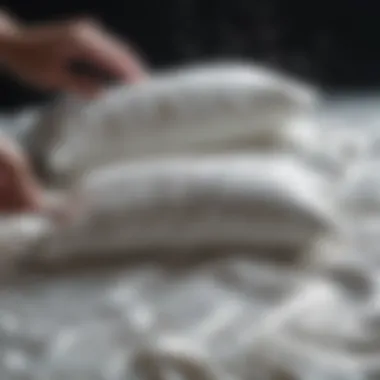
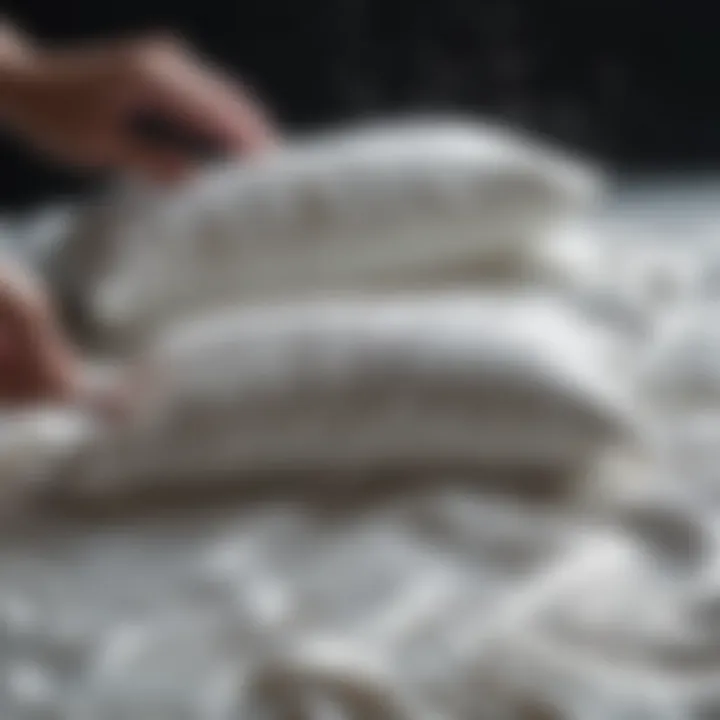
By using a controlled space, you help mitigate potential problems, but make sure it’s also easy to access for comfort and efficiency.
Proper Light Conditions
Lastly, having the right lighting is vital when preparing to wash your silk pillowcases. Good lighting helps in seeing any stains or spots that need extra attention before washing.
- Key Characteristic: Bright but natural light can enhance visibility, allowing for thorough inspection.
- Unique Feature: Moreover, it can help in spotting any damage pre-emptively during your care routine.
While having a well-lit area is advantageous for attention to detail, overly harsh artificial lights could cast unflattering shadows and mislead your evaluation of the fabric’s condition.
The Hand Washing Process
Hand washing silk pillowcases is a crucial step that preserves the delicate nature of the fabric. Unlike cotton or synthetic materials, silk requires a gentle touch and careful attention to detail. This process not only removes dirt and oils but also helps maintain the luxurious feel and appearance of the silk. Given silk's susceptibility to damage, this method ensures that each pillowcase can continue to provide comfort and aesthetic charm for years to come.
Step-by-Step Washing Instructions
Prepare the Wash Basin
The first key aspect of the washing process is preparing the wash basin. Opt for a clean, shallow basin filled with cool water. This is vital because silk responds best to cooler temperatures, which prevent any potential mishaps like shrinkage or color fading. A spacious basin gives enough room for the pillowcase to move freely, reducing the chances of creasing or damage.
Dilute Detergent
Next, diluting the detergent before introducing it to the silk pillowcase is essential. Using a silk-safe detergent makes a world of difference. When you mix the detergent with water, it ensures that it distributes evenly throughout the wash. An ideal diluted solution further protects the fabric’s natural fibers, preventing them from being overwhelmed by harsh chemicals.
Gently Agitate the Pillowcase
Once the detergent mixture is ready, it’s time to gently agitate the pillowcase. Instead of scrubbing or harsh movements, think of this as a light massage. The aim is to allow the soapy water to cleanse without causing friction. This, too, helps in maintaining the integrity of silk fibers, allowing them to remain soft and smooth. A cautious touch here is the better choice; silk deserves no less.
Rinsing Techniques
Use Cold Water
When it comes to rinsing, using cold water is quite beneficial. Cold water works to seal in the silk’s natural softness while also effectively removing any soap residue. Not only does it keep colors vibrant, but it also prevents fabric degradation that can occur with heat. Keeping the water cool is one of those golden rules that make a difference.
Avoid Twisting or Wringing
During the rinsing phase, it is crucial to avoid twisting or wringing the pillowcase. This method can stretch the fabric and lead to unnecessary wear and tear. Instead, simply let the water run through, or gently press the pillowcase between your palms until excess water is removed. It’s a much gentler process that respects the fabric’s nature.
Ensure Residual Detergent Removal
Lastly, ensuring thorough removal of any residual detergent is significant. Residual soap can lead to skin irritation and diminishes the fabric's natural shine over time. A well-rinsed pillowcase breathes better and retains its luxurious quality, further enhancing your sleep experience. Take extra care to check for any suds before calling it a day.
Drying and Storing Silk Pillowcases
Caring for silk pillowcases isn’t just about washing them correctly; how you dry and store them is just as crucial. Proper drying and storage can significantly enhance the lifespan and appearance of silk. Those who expertly care for their silk will tell you that it’s not merely a fabric; it’s an experience. When you take care of silk pillowcases properly, they can maintain their sumptuous feel and aesthetic allure for years to come. Here, we discuss the key aspects of drying and storing those treasured silk pillowcases.
Proper Drying Methods
Laying Flat on Soft Towels
One of the most effective methods to dry silk pillowcases is to lay them flat on soft towels. The gentle surface of the towel absorbs moisture without causing friction. This technique is quite popular among those who know the ropes of silk care because it helps maintain the delicate texture of the fabric. When you lay your pillowcase flat, it prevents stretching or creasing which contributes to its softness and beauty.
However, it's important to make sure that the towels are clean and very absorbent. A highly recommended choice can be a cotton towel, allowing for balance between absorption and gentleness toward your silk. While laying silk flat is advantageous, one needs to be cautious about the potential for the fabric to become damp for an extended period, which could cause mildew in humid conditions.
Avoiding Direct Sunlight
When drying silk, you should sidestep direct sunlight like it’s the plague. It’s a cardinal rule because the sun can bleach colors, leading to fading and an overall dull look. Protecting your pillowcases from harsh light is highly beneficial as it preserves the nuances of color and pattern that make silk so appealing.
Instead, consider using a shaded area or a room with ample airflow. The unique feature of this method is that it allows the fabric to dry naturally, preventing damage from UV rays. Just remember, it might take a bit longer, but a little patience is a small price to pay for keeping that luxurious sheen intact.
Humid Environment Considerations
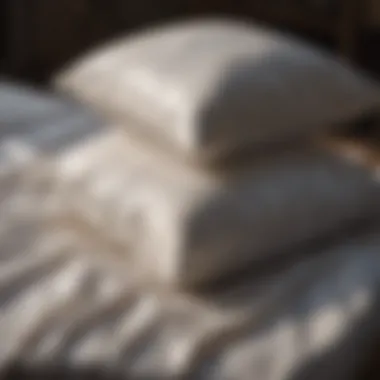
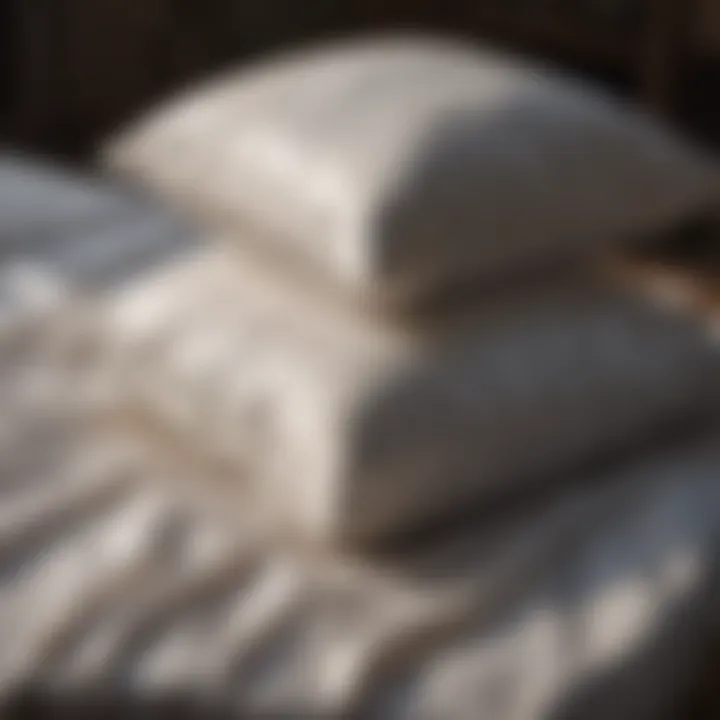
Humidity can be a double-edged sword when it comes to drying silk. On one hand, a bit of humidity can prevent the fabric from drying too quickly, which is good because rapid drying can lead to damage. On the other hand, excessive moisture can lead to mold and mildew growth, ruinous for your treasured pillowcases.
So, whatever the case may be, monitor your silk as it dries. An ideal drying environment is one with moderate humidity levels. If you live in a very humid area, it might be worth considering a dehumidifier in the space where you dry your pillowcases, as this can be crucial for their longevity.
Storing for Longevity
Temperature and Humidity Control
To maintain the luxurious quality of silk pillowcases, controlling temperature and humidity when storing them is paramount. Silk is generally happiest in a cool and dry environment. Excessive heat can lead to weakening of the fibers, while high humidity fosters mold growth, which can be detrimental.
A closet with stable temperatures works wonders for silk. It helps in retaining both color and structure. The key characteristic here is making sure not to store silk in damp basements or excessively warm attics. Both extremes can cause irreversible damage to your fine fabrics.
Using Breathable Bags
Storing your silk pillowcases in breathable bags instead of plastic ones allows for essential airflow. This practice helps prevent the buildup of moisture that could lead to mildew or a musty smell over time. The unique feature of breathable storage is that it shields the silk from dust and other pollutants while still allowing your cherished pillowcases to breathe.
A cotton or linen bag might just do the trick. However, you should always ensure that the bags are clean and free from any remnants of harsh detergents or scents that could taint the fabric.
Avoiding Heavy Objects on Top
When storing silk pillowcases, it’s vital to avoid placing heavy objects on top. This sounds like common sense, but you’d be surprised how easily one might neglect this principle in a crowded closet. Heavy items can crush and distort the silk, making it lose its shape and softness.
Instead, stack silk pillowcases neatly without any weight resting on them. This practice retains the luxurious feel and look while preventing unsightly creases. Moreover, it extends the usable life of your pillowcases, allowing you to enjoy their comfort and beauty without any compromise.
By paying attention to how you dry and store your silk pillowcases, you’re not just following best practices; you’re ensuring that you continue to experience the luxury they bring to your sleep and home.
Common Mistakes to Avoid
Taking care of silk pillowcases requires certain diligence, and avoiding common pitfalls can help maintain their luxurious feel and appearance. Silk, being a delicate fabric, responds poorly to a few missteps. Understanding these mistakes is crucial for anyone looking to preserve their investment in luxury home textiles. Here are some key mistakes to sidestep:
Ignoring Washing Instructions
Every silk pillowcase likely comes with specific washing instructions, and overlooking these can lead to disastrous results. Ignoring the care guidelines means risking fading colors, texture deterioration, and even irreparable damage. For instance, some silk pillowcases may require cold water, while others can withstand a gentle warm wash. If you throw your pillowcase into the wash without a thought, you may not only distort its color but also ruin its unique sheen.
Furthermore, certain silk blends might be less forgiving than others. Always check the labels as they underline the best practices that keep your pillowcases looking fresh. They are not just recommendations; they’re necessities when it comes to maintaining your silk's integrity.
Using Harsh Chemicals
A common oversight among consumers is opting for standard laundry detergents. Harsh chemicals can strip the silk of its natural oils and delicate fibers, resulting in the fabric's degradation over time. Instead of brightening your pillows, these detergents can cause color loss, matting, and even create a wiry texture that feels unpleasant against your skin. It’s smart to invest in silk-safe bod detergents—these are designed specifically for delicate fabrics and won't compromise the fibers.
When in search of alternatives, be sure to avoid fabric softeners and bleach as these products can wreak havoc on silk, causing stains or making the fabric weaker. Gentle, natural sources like baby shampoo or even a mild pH-balanced soap can be a far better choice—it's softer on the material and still gets the job done.
Neglecting Regular Cleaning
Just because silk pillowcases look pristine doesn't mean they don't require regular care. One significant mistake people make is neglecting to wash their silk pillowcases frequently enough. Build-up from natural oils, sweat, and even dust can affect the pillowcase’s texture. Ideally, washing your silk pillowcases every one to two weeks is best practice. They might seem to have retained their beauty, but grime lurking beneath may deteriorate fibers over time.
Regular cleaning ensures that your silk pillows continue to exude luxury and comfort. So set a reminder on your phone, or toss a sticky note on the fridge—anything to keep you accountable on this matter.
Final Thoughts on Silk Care
Caring for silk pillowcases goes far beyond merely washing and drying. When you invest in such exquisite textiles, establishing a care routine is the linchpin of ensuring their durability and continued beauty. By adequately maintaining these luxurious items, you not only extend their lifespan but also preserve their elegant appearance.
Establishing a Care Routine
A good routine is like having a secret sauce that keeps your silk looking fresh. To start, it helps to schedule regular cleanings. Depending on use, washing both sides every couple of weeks should suffice. While hand washing is paramount for silk, if stains crop up after a social gathering, addressing them immediately with spot cleaning can prevent long-term damage. Gentle treatments using silk-friendly products can do wonders. For instance, using a delicate detergent and testing it in a small section ensures you're not pouring a recipe for disaster onto your pillowcase.
In terms of handling, always treat your silk with the utmost care. It’s best to avoid tossing them into a laundry basket with heavier clothes, as friction can lead to unsightly snags or pulls. To establish an effective care routine, consider keeping your cleaning supplies together—perhaps a charming wicker basket—so you have everything on hand. Make it a habit: when you wash your sheets, think about your pillowcases too.
The Role of Quality in Maintenance
Maintaining silk is an art, and the quality of the materials you select plays a crucial role. Investing in high-quality silk pillowcases simply pays off in the long run. They can withstand the wear and tear of regular use far better than cheaper alternatives, which often fray or lose their sheen after several washes.
It’s also essential to source silk from reputable manufacturers. Quality silk tends to have better durability and aesthetics, thus enhancing your home’s elegant vibe. Brands that prioritize sustainable practices often provide a more ethically sourced product, which elevates the care experience.
When caring for your luxury silk, remember this: It’s not just about cleaning; it’s about enhancing the luxurious experience they provide. Proper maintenance adds to the tranquility of your home oasis. When you treat your silk with respect, it rewards you with a serene space to dive into each night.
"Quality is not an act; it is a habit."







